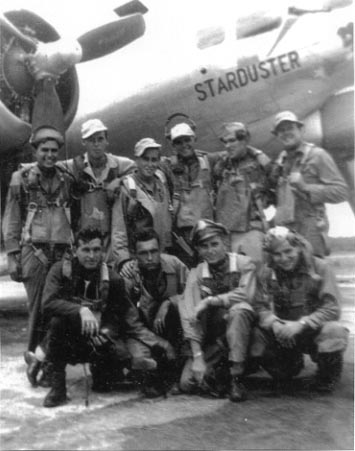Irv Pliskin, a navigator on a B-17 during World War II, will share a series of his memoirs on his service to our country from Induction through his time in a German Prisoner of War camp. This is the first in his series.
We were eager, fearless young men. The picture is a little out of focus, and I don’t remember when it was taken or even posing for it. Although, by the clothing and the uniforms and the flight suits, I know it was taken while we were in pre-combat training in Avon Park, Florida.
That was in the summer of l944.
That sort of vintage picture is fairly typical of the time: the aircrew lined up in front of a B-17. Six men are standing, four kneeling in front. When I look at that photo, as well as the other one I have of the crew taken at the 95th Bomb Group base in Horham England, on one of the days we were not flying combat, I can’t help getting choked up. My chest tightens. I feel a tear roll slowly down my cheek, and I experience a painful sense of loss because of the nine members of my crew, only three of us survived. I made it. I was the navigator. Roger Rand, the pilot, made it; and Bob Bright, who made it most miraculously.
The fact that Bob got out of that airplane is a miracle. The ball turret on the B-l7 hangs below the main part of the fuselage. It is located just behind the wings and the bomb bays. The ball turret gunner fits in the ball like a fetus in the womb, and in practically the same position. He lays on his back, feet on either side of the twin fifty caliber machine guns, and points his fanny at the target. The ball turret is a cold, isolated, lonely place to be. It is hard to climb into and almost impossible to get out of without strong arms to help pull you up. Somehow Bob managed to get out, all by himself.
I sincerely hope the others of the crew have been resting peacefully all these years.
I took the picture Bob sent to the local one-hour photo store to enlarge it as much as possible and the man there looked at it and said, " Your father (wasn’t he kind?) has to be in this. This is an old picture and folks enlarge these only when family is involved."
I smiled, and showed him where I was in the picture. "Not my dad at all," I said. "It is one of those ‘I was there’ pictures."
We started talking about my experience during the war, and he ended up giving me the enlargement as a gift, because he said, "You guys deserve everything, you were all heroes."
I don’t know about the hero bit, but I thought about it and the questions he asked me and decided that perhaps there are folks who might like to share some of the answers.
We got shot down on our 23rd mission. We had only to fly a dozen more missions to complete our tour and go home. Our target was Cologne, the German city on the Rhine River. We were to bomb the bridges and try to destroy them to disrupt shipping and supplies to the German troops.
"Keep away from the cathedral," the briefing officer said. "Make sure you don’t damage the thing. That’s an order."
Cologne, we believed, was not much of a threat to us. We had been there twice before without any problems, so when they pulled back the map curtain in the briefing auditorium, and we saw the target route marked out , we breathed a sigh of relief.
Cologne was a "milk run", which was a term we used for a very easy, not-too-risky mission.
We were briefed for thick cloud cover beneath us, which would obscure us from the German ant-aircraft guns, and with very brisk tail winds at our bombing altitude, which would move us over the target area at well over 400 miles per hour, ground speed. Hence, a "milk run".
There was a snafu (to find out the real meaning of snafu, consult a WW11 veteran: I can’t provide the translation in a family magazine) and when we got over Germany, we found that the winds had shifted and the change in weather had blown the cloud cover away. So we were totally exposed and vulnerable to the German Anti-Aircraft gunners.
There were very strong headwinds, which slowed us down considerably. Accordingly, we were to go over the target in clear view from the ground at about l00 miles per hour: sitting ducks for the German gun batteries.
What was to have been a milk run became a disaster. Instead of a three-minute bomb run as briefed, we had a l2- minute bomb run from the initial point, the imaginary spot from which we turned to the target for the bomb run.
We had been flying in a steady, non-evasive position for eleven minutes, when the first of the flak exploded right in front of us. The Kraut shells were set to explode at specific altitudes. Since they had us in clear sight, it was easy for them to determine our exact elevation. When they shot at us, the shells exploded right in front of the aircraft showering the area with pieces of metal, which we called flak. We were carrying a bombsight, so we could not take evasive action; bombsights demanded straight and level flight until the bombs were dropped.
Exploding flak looks like a firecracker gone mad. First there is a flash of fire, and then the area is engulfed in black, thick smoke. When you see the smoke, the danger from that artillery round is past.
"Flak!" somebody shouted on the intercom. "12 o'clock level!"
"Flak Level, Flak level" the subsequent calls came, and then we were hit, directly between the number two engine (the second engine on the left side of the airplane) and the fuselage. The noise was deafening, and if it had not been that we were wearing earphones we might have lost our hearing then. The plane shook, fell off on the left wing, and nosed down. It began to lose altitude, but it did not nose over into a dive. Randy held it in a shallow descent, at about one thousand feet a minute.We lost internal communication; we lost our compass and direction. The plane began to burn,
fiercely . . . but it continued to fly. The electrical system I learned later was out, so there were no alarm bells to indicate "Abandon Ship."
My position was even more unusual than it normally was. Soon after we had taken off at 5 AM and began to climb to altitude, moisture in the nose compartment of the B-17 began to freeze, and it coated the Plexiglas with white rhyme ice.
Neither the bombardier or I could see outside the ship.
We had an electrical panel for the bombsight, so that was clear, but in terms of normal vision, there was none. As a result I was not really aware of the gravity of the fires.
Mullins, the bombardier, got up from his seat and indicated that he wanted an auxiliary oxygen supply, a walk around bottle. I gave him one, and helped him snap it on. I also snapped on his parachute chest pack, making sure it was secure. I had put mine on one hook when we turned on the IP, so all I had to do was snap the other side to the parachute harness O ring. Mullins crawled through the bulkhead opening to stand between the pilot’s position. He never moved from there, so far as I could see. Had he reached for the escape hatch door, which was at his feet, I think I may have beaten him out of the airplane.
The nose of he B-17 is separated from the rest of the plane by a bulkhead: the only person I ever saw during missions was the Bombardier. The crew communicated with each other only by intercom and no one ever really expressed his feelings on the intercom, unless there was a problem. Regardless of your position, there was a strong sense of personal isolation when you flew combat in a B-17.
She flew, losing altitude for about three minutes and I kept telling myself to get the hell out of there. But, so long as she flew, you don’t want to leave and I was convinced we would finally be okay. We had started the bomb run at about 25,000 feet. I told myself I would jump at 20,000. I kept my eye on the altimeter.
When we got to 20,000 I thought I would wait to l8,000.
At l8,000 I decided to wait until we got to l5,000. (In those days altimeters worked on pressure, so even with the electrical system out, the instrument continued to register altitude - the approximate height at which the plane was flying.)
At about l6,000 the airplane fell off into a spin, and I was thrown into the Plexiglas nose compartment. I remember the sudden change in position of the airplane, as it nosed over into a dive. I covered my face with my hands reflexively, and that is the last I remember of that flight.
The B-l7 blew up, and I was blown out of the Plexiglas nose compartment into the blue afternoon sky. I was momentarily unconscious, so I am not sure how my parachute opened - but it did. Although I should probably have been petrified, I don’t remember any such feeling. I had a conviction that we would continue our controlled descent and fly over the enemy lines and back home. That was of course, unrealistic and stupid.
I woke up seconds after the explosion in time to see pieces of empennage floating around me and drifting lazily to the ground. I had a sharp pain in my groin from the parachute straps and had a cut on my wrist. The copper taste of blood filled my mouth from the cut under my chin. The silk glove on my left hand was full of blood, so without thinking, I took it off and threw it away. I was floating all alone in deep silence in the sub-zero temperatures.
I looked up and saw our airplanes flying home, leaving heavy contrails. There was also a huge tear in my silk chute, and I remembered a training exercise when we were told not to worry about such things. The trainer had said the parachute would hold. I never looked up again. I looked down and saw engines burning on the snow-covered ground. I was bleeding, and I was in shock, but I had a single thought.
Well, at least my war is over - or so I thought.
Irv Pliskin is a retired advertising agency owner. He is a combat veteran of World War II and an Ex Prisoner of War of the Germans. Married, with three kids, and four grandchildren he devotes his time to writing flash fiction. He hopes, that someday, he may become the Grandma Moses of flash fiction. He lives with his wife of 57 years in Cherry Hill,NJ.

